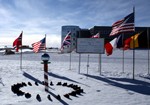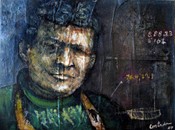The Antarctic Sun
January 21, 2007
Miami artist aims to raise environmental awareness through newly created works that incorporate elements of the continent
By Peter Rejcek

Photo Credit: Peter Rejcek Miami artist Xavier Cortada puts the finishing touches on a painting he created while at McMurdo Station. He donated the piece to the local community.
Miami artist Xavier Cortada came to Antarctica to spread the word about climate change and to educate the public in the little-known scientific and historic facts about the seventh continent.
But he didn’t quite expect for his brief journey here to change his own artistic style so radically.
The artist’s traditional work pulses with tropical colors, as if living jungle had flung itself onto canvas to be recast in Technicolor wonder. A mangrove seedling seems to serve as his most holy symbol, representing the roots of community in the way that the seed, when it washes up on a sandbar, grows and creates a new ecosystem.
Yet, in the scores of small watercolor paintings spread around a laboratory room in McMurdo Station’s main science building, Cortada’s bold colors, his familiar symbols and splashes of style, are missing. The cool blue colors of glacier ice swirl in abstract shapes on 8-by-11 papers, peppered with texture thanks to soil samples from the McMurdo Dry Valleys.
Boxes of paint tubes and bottles will return with him to Miami unused. Blank canvas sits in a nearby chair, folded like bed sheets.
“Instead of going home with drawings of icebreakers and mountaintops, I’m going home with abstract pieces created from samples of Antarctica, and I think that’s good, that’s the exploration and resonance it was created from,” said Cortada, his round face beaded a bit with sweat from the overheated room.
He was trying to dry the paintings, still wet from the sea ice that he had used both as a watery base for his paints and as a brush, before flying north the next day.
“I’ve never been so prolific and inspired as I’ve been here,” he added. “It’s been the ultimate artist residency.”
It was also a fast-paced residency under the National Science Foundation’s Antarctic Artists and Writers Program. Cortada churned out a half-dozen pre-planned projects in just two weeks, including several temporary installation pieces at the South Pole. He flew there for a one-day mad scramble, though at one point weather threatened to cancel the venture altogether.
But a window opened in the weather on Jan. 4 — 50 years to the day when construction of the first U.S. South Pole station was completed — and he and his partner Juan Carlos Espinosa, a musician and sound artist, reached 90 degrees south.
Conceptualizing climate change
Cortada called one temporary exhibit Longitudinal Installation. It involved placing 12 pairs of nondescript black shoes around the ceremonial South Pole, which resembles a barbershop pole topped with a mirrored orb like the tip of some magician’s wand.
Inside the sole of all 24 shoes, he had painted degrees of longitude, so that each shoe would represent 15 degrees of distance. At the Pole, where the world converges, they conceptually come together in a tight circle.
He chose 24 news items from around the world that would roughly correspond to the longitudinal location of each piece of

Art installation by Xavier Cortada at South Pole.
footwear. Each clip was a voice in the global wilderness, a warning about the impacts of environmental degradation.
He read each news story aloud. Espinosa recorded the performance, which took place in temperatures that dipped to about negative 17 degrees Fahrenheit.
For example, one news item from Colorado at 105 degrees west said, “In Colorado, climate change means less snow, less water, more wildfires, less biodiversity and less economic opportunity, as there is less water available for development.”
“I wanted to make the South Pole this global campfire where people would come and talk,” Cortada explained. “The South Pole is where all these longitudes converge … by literally putting these people’s voices inches apart from one another from where they stand on the world at the South Pole, I conceptually diminish the distance, so we can empathize and care more.”
The next project was somewhat similar, but Cortada expanded the notion of how human-induced climate change affects not just people but also other species. He painted 24 flags with degrees of longitude and the scientific names of 24 endangered or threatened animals.
Both installations will be reproduced for a June exhibit in Oslo, Norway, for United Nations World Environment Day 2007, in a show the Natural World Museum is producing in partnership with the United Nations Environment Program.
Cortada has created works for numerous public institutions, includ¬ing the White House, the World Bank, the Florida capitol, the Florida Supreme Court and the Miami Art Museum.
Not all of the Antarctic projects revolved around the theme of climate change and global warming.
Passing time
A different concept played with time. Cortada poured South Pole water into the mold of a mangrove seedling to create an ice counterpart to one of his familiar symbols. He then buried the inorganic seed at the geographic Pole, which rests on a moving ice sheet. In about 150,000 years, Cortada said, that seed would reach the Weddell Sea.
Cortada said the piece reminds people that the immediacy of political or societal concerns is far less important than we might think. “We forget that we’re just a small passing moment in a broad spectrum of time.”
He stretched out a shorter timeline in Markers. For this installation, Cortada dug 50 holes to plant flags that correspond with the 50 spots where the geographic marker has stood over the last half-century. The ice sheet moves about 30 feet, or 10 meters, each year and the marker is relocated on New Year’s Day. Cortada chose pivotal, inspiring moments from history to represent each year. For instance, the marker for 1989 represents the fall of the Berlin Wall.
This geological timepiece was half a kilometer long. “I love the idea of a moving ice sheet to explain Antarctica,” Cortada said.
Shackleton imbued with life
The prolific artist didn’t stop with these one-hit wonders designed to shock the mind off its normal line of thinking. He also painted a portrait of Antarctic hero and explorer Ernest Shackleton while he was in McMurdo and presented the painting to the South Pole station management during his brief visit.
“Shackleton to me is the epitome of the Antarctic hero,” Cortada said. “He opened up this continent to us.”

Cortada’s rendition of Antarctic explorer Ernest Shackleton.
Shackleton failed to reach the Pole in life. Cortada imbued his painting of the famed British explorer with some unusual elements for his long overdue arrival.
He used GIS maps of the continent that traced Shackleton’s various expeditions. He also overlaid historical photos for the portrait before painting it. The materials used in the paint included glacial ice, dirt from the Dry Valleys and even crushed crystals from Mount Erebus.
“I think the painting is very significant,” said Jerry Marty, the National Science Foundation representative at South Pole. “Shackleton’s Antarctica expeditions and his leadership pioneered — almost 100 years later — a continent being used for scientific research, without ownership, and for peaceful purposes.
“The temporary installations of climate change and notions of geologic timeline were very powerful,” he added.
A new style
Antarctica exerted its own power on Cortada, particularly for his last project, an 8-by-4-foot painting that he donated to the McMurdo community. The second-generation Cuban-American artist combined his traditional style with his emerging intuition for abstract images. He had solicited comments from people at McMurdo’s local art show for the piece. The question: why had they come to Antarctica?
Participants wrote their answers on note cards, which he adhered to the borders of the canvas, a GIS map of the Ross Island region. Jess Walker, a GIS analyst at McMurdo who creates the maps for the U.S. Antarctic Program, worked with Cortada on finding the right maps for his projects.
“I think there’s a lot about a map that lends itself to artistry,” Walker said. “We spent quite a bit of time looking at maps.”
The Ross Island map particularly appealed to Cortada because of a whim¬sical swirl on the left side of the digitally created image, the turning basin created by the annual icebreaker in the sea ice.
“It’s like a doodle on the water,” he exclaimed, apparently delighted by the playful imagery the shape lent to the overall image. Ross Island, where United States and New Zealand science stations sit, disappeared under a firework display of color created by Cortada’s brush.
Over the note cards, he wrote in all of the science events for the season. The final layer of the painting again included some texture thanks to the Dry Valleys.
“I’ve used Dry Valleys’ dirt everywhere,” said Cortada. “I wanted Antarctica in the art.”
And Cortada wants back in Antarctica. He said he already has plans to apply for another NSF grant. The artist has not fully fleshed out the concept, but he would like to venture to the Dry Valleys or Mount Erebus with a field team for several weeks.
“Part of my excitement about this has been dealing with the Antarctic scientists,” he said.
NSF-funded research in this story: Xavier Cortada, Antarctic Artists and Writers Program.